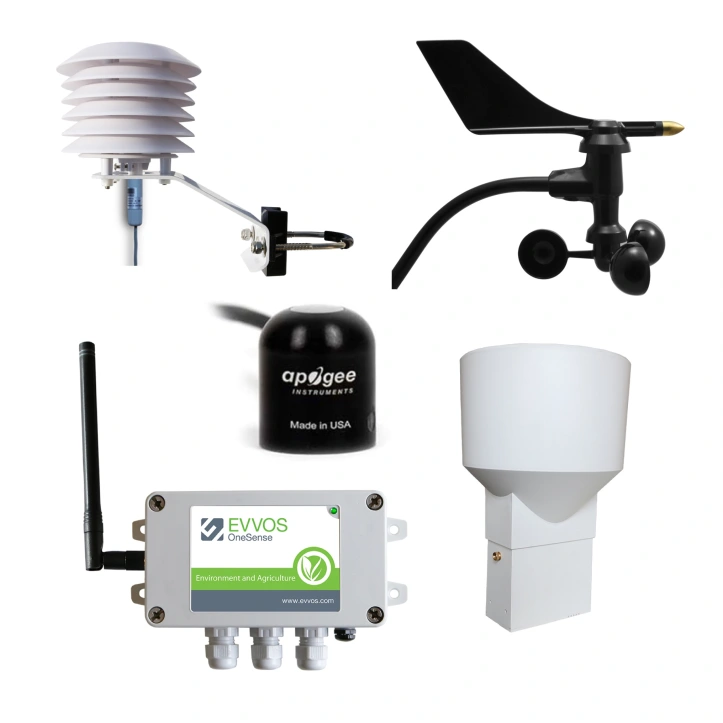
Evvos Weather Station EWS-4
Highlights:
- Accurate, reliable weather monitoring
- 23 weather variables
- GPS (optional)
- Enclosure ingress protection class IP66
- Operation temperature range -20 °C to +70 °C
Evvos Weather Station EWS-4 includes:
- relative humidity, temperature and barometric pressure sensor with a solar radiation shield rain gauge wind speed and wind direction sensor silicon-cell pyranometer (ISO 9060:2018 Class C)
- battery-powered wireless data transmitter with an optional solar panel GPS (optional)
- 1-year connectivity license 1-year CIS (cloud integration services) subscription
This weather station provides accurate and reliable weather monitoring and a total of 23 weather variables.
- Relative Humidity
- Ambient Temperature
- Barometric Pressure
- Rainfall
- Wind Speed
- Wind Direction
- Solar Radiation
- Heat Index
- Dew Point
- Frost Point
- Wind Chill
- Wind Chill Index
- Water Vapour Pressure
- Saturated Vapour Pressure
- Speed of Sound
- in Air Mixing Ratio
- Specific Humidity
- Absolute Humidity of Air
- Boiling Point of Water
- Enthalpy
- Atmospheric Moisture by Weight
- Atmospheric Moisture by Volume
- Wet-bulb temperature
It is important to measure variations in conditions within a field to prevent farmers from applying the same amount of fertilizer over an entire agricultural field. Weather conditions such as wind, temperature, relative humidity and precipitation have direct impact on the effectiveness of spraying applications and the influence waste potential due to run-off and drift.
Relative Humidity and Temperature
Know your relative humidity and temperature – avoid unnecessary and costly trips to the field. Spray when temperatures are low and relative humidity is high. In general, do not spray when relative humidity is less than 40% and air temperature is above 25°C. This reduces the chance of drift due to temperature inversions or evaporation. It also increases target deposition and coverage. Hot and dry conditions increase drift because droplets rapidly evaporate and become fine droplets, vapour or particles of concentrated pesticide. Optimum spraying conditions are early mornings following overcast nights. However, the best time to spray to avoid disrupting bee activity is evening or at night.
Wind Speed
Know your wind speed – avoid unnecessary and costly trips to the field. Wind direction determines whether droplets travel toward the target or toward unintended downwind areas such as open water, sensitive crops or areas of human activity. Wind speed affects the distance a droplet will travel before it is deposited on the target. Rainfall Know your precipitation – avoid unnecessary and costly trips to the field. Rain can have both a positive and a negative effect on spraying. Some products work best when rain water carries them into the soil after application, but not far enough to enter the water table before they do their work and break down. Depending on the rainfastness of the product, rain soon after application may also wash the product from leaves and reduce the level of protection. While rain can also redistribute certain products over the target, do not rely on this for distribution. Monitor your weather parameters and understand the impact on the product being applied. Avoid spraying when foliage is still wet from rain or dew unless indicated by the label. A leaf can retain only a limited volume of spray, and therefore a limited amount of product. Once wetted, deposition will not increase beyond the tank concentration and the surplus will run off to the lower leaves and onto the soil.
Set Your Crops Up for Success
Weather conditions are an important factor that you should consider when making the decision to head to the field. With all the pressure to get started planting, spraying or harvesting, it is important to take the time to ensure you are setting your crop up for success.
Contact us at sales@evvos.com to inquire not just about sensors and work management but also pest control, disease models and irrigation.
Typical Applications Agriculture Agricultural Research Environmental Monitoring


